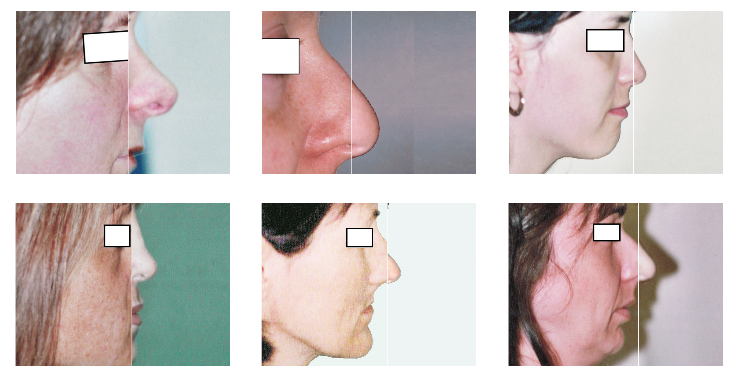By Dr. Duclos Cosmetic Surgeon in Montreal
Presentation of Rhinoplasty
A traditional rhinoplasty is a surgical operation that aims to change the shape, size or function of the nose. It can be performed to correct an aesthetic aspect of the face such as a nose that is too large, a humped or hooked nose, a tip of the nose that is too wide, drooping or pointed.
Rhinoplasty is also suitable for cases of deviation of the nasal septum, or to treat breathing problems. Rhinoplasty can be performed in an open or closed manner, depending on the patient’s needs. It can also be combined with other aesthetic procedures such as contouring of the chin or cheekbones. Recovery after rhinoplasty varies depending on the extent of the procedure, but in most cases, patients can return to their normal routine around 10 days after surgery.
There is also non-surgical rhinoplasty which is increasingly popular and which involves injecting a filler substance such as hyaluronic acid. This technique is used to reshape the nose when for example the nose is flat, when the nose is irregular, deviated or asymmetrical. This is a technique which has several advantages since no anesthesia is necessary, this is done in the clinic and not in the operating room, the correction is made in a few minutes, the result is immediate, there is little time edema and recovery is rapid since no convalescence is required.
The different types of noses in rhinoplasty
In rhinoplasty, there are several types of noses that plastic surgeons can modify or correct. Among the most common types of noses, we can cite:
1. The hooked or aquiline nose:[example photo] it has a pronounced bump on the bridge of the nose, which can be corrected by smoothing the bumpy area or lowering the bump.
2. The bulbous nose:[photo example] this type of nose has a broad, rounded, prominent tip that can be refined and sculpted to give a more elegant appearance.
3. The long nose:[photo example] an elongated nose can be shortened or reshaped to reduce its length or improve its overall appearance.
4. The snub nose:[photo example] this type of nose has a ball-shaped tip, which can give the appearance of a nose that is too short. Using rhinoplasty techniques, the tip of the nose can be lengthened and refined to give a more natural appearance.
5. The asymmetrical nose:[photo example] if the shape or structure of the nose is asymmetrical, it can make the face inharmonious. Rhinoplasty techniques can be used to realign the bony structures of the nose and create more balanced facial symmetry.
6. Flat nose:[photo example] if the shape of the nose is flat, a non-surgical rhinoplasty can be performed by injection of hyaluronic acid or the placement of an implant.
These different types of noses are not exhaustive, as each individual is unique and may have a combination of characteristics that requires personalized intervention.
During the consultation, Dr. Duclos listens to your needs and takes into consideration the preferences of her clients.
Gallery of before-and-after photos of different types of rhinoplasty

What does the surgical operation consist of?
In general, a rhinoplasty procedure lasts approximately one hour 30 minutes to two hours and is carried out under general anesthesia.
Here are the common steps of the intervention:
- The surgeon makes a discreet incision inside or outside the nose, depending on the technique chosen and the objective of the operation.
- It peels off the skin to access the bone and cartilaginous structure at the base of the nose.
- It reshapes this structure using precise instruments (osteotomes, rasps, scissors, forceps, etc.) to remove, add or move parts of cartilage and bone.
- He drapes the skin and fixes it with sutures, molds the nose with tights and applies a nasal splint which helps maintain the new shape of the nose.
After the procedure, the patient is monitored in the recovery room and then leaves the clinic to rest at home. It is recommended to sleep semi-sitting to reduce swelling. There is little pain following surgery. Medication is prescribed. Recovery time varies depending on the extent of the procedure, but strenuous physical activities and sudden movements should generally be avoided for the first few weeks. Bruising and swelling are present and gradually disappear. The final results of rhinoplasty may take several months to appear, as the nose slowly reshapes and adapts to its new configuration.
What are the different techniques for rhinoplasty?
There are several surgical techniques for rhinoplasty:
- Classic surgical rhinoplasty: it consists of incising the columella (area of skin and cartilage between the two nostrils) to access the internal nasal structures and reshape them.
- Closed surgical rhinoplasty: it is performed through incisions inside the nostrils to access the internal nasal structures. It is a less invasive technique than traditional rhinoplasty.
- Ethnic rhinoplasty: it is specifically adapted to the anatomical characteristics of patients of African, Asian or Hispanic origin.
- Surgical reduction rhinoplasty: it is used to reduce the size of the nose.
- Surgical augmentation rhinoplasty or non-surgical: it is used to increase the size of the nose using tissue grafts, implants or filler injections.< /li>
These techniques are used according to the specific needs of each patient and the complexity of their case.
During your surgery consultation at the Rosemont clinic Dr. Duclos carries out a meticulous examination to advise you. She aims to make the nose more harmonious in relation to the whole face and so that it better reflects your personality. For example, a nose that is too short will not be suitable if the face is long. A coarse or prominent nose is not suitable for a face with delicate bones. Sometimes the nose is too flat, the nostrils too wide, etc.
Dre Duclos masters several rhinoplasty surgical techniques which ensures that the nose will be personalized according to your criteria and your morphology. You can see this by the before and after post-operative examples presented here in this article.


